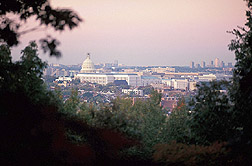This page has been archived and is being provided for reference purposes only. The page is no longer being updated, and therefore, links on the page may be invalid.
|
|
Arboretum Pitches in to Clean up Chesapeake Bay TributaryBy Alfredo FloresJuly 23, 2004 WASHINGTON, July 23, 2004--The U.S. National Arboretum and collaborators have signed a historic agreement that will lead to the design, construction and maintenance of a pollution abatement system to be installed on the arboretum grounds to help reduce pollution in the Anacostia River. The arboretum, operated by the Agricultural Research Service (ARS), is collaborating with the District of Columbia Department of Health and the District of Columbia Water and Sewer Authority on the project. ARS is the U.S. Department of Agriculture's chief in-house scientific research agency. "This agreement among ARS and cooperating agencies in the District will help significantly reduce pollutants entering the Anacostia River and eventually the Chesapeake Bay," said ARS Administrator Edward B. Knipling. The discharge of an extensive storm water drainage system for about 800 acres of northeastern Washington, D.C., is located on the northern boundary of the arboretum adjacent to New York Avenue. This discharge is carried by a smaller stream, called Hickey Run, into the Anacostia, where it eventually flows into the Chesapeake Bay. For the past 50 years, significant amounts of solid and liquid pollutants from roads, parking lots, residences, businesses and industries have been washed into this drainage system with every heavy rain. To help mitigate this problem, ARS will design and construct a system to catch floating debris and to reduce oil and grease pollution that would otherwise enter Hickey Run. Arboretum staff are also working with counterparts at the District of Columbia Department of Health and the U.S. Fish and Wildlife Service to develop detailed plans for renovation of Hickey Run below the pollution abatement system. In this way, the arboretum will play a major role in reducing pollutants to the Chesapeake Bay watershed while improving the appearance of its own grounds. |


